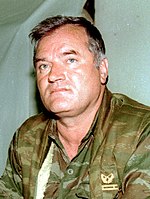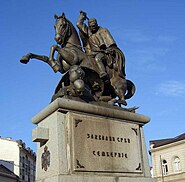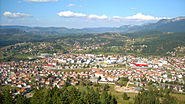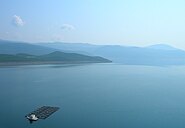Republika Srpska Република Српска Republika Srpska | |
|---|---|
 Location of the Republika Srpska (orange) within Bosnia and Herzegovina.a | |
| Capital |
|
| Official languages |
|
| Government | Parliamentary system |
• President | Milorad Dodik |
• Prime Minister | Željka Cvijanović |
| Legislature | National Assembly |
| Formation | |
• Proclaimed | 9 January 1992 |
• Recognized as part of Bosnia and Herzegovina | 14 December 1995 |
| Area | |
• Total | Template:Convinfobox/prisec2 |
• Water (%) | n/a |
| Population | |
• 2010 estimate | 1,439,673 c |
• 1996 census | 1,437,477 d |
• Density | Template:Convinfobox/prisec2 |
| Time zone | UTC+1 (CET) |
• Summer (DST) | UTC+2 (CEST) |
| Calling code | +387 |
| |
The Republika Srpska (![]() listen (help·info) Bosnian, Croatian, Serbian: Republika Srpska, Cyrillic: Република Српскa, [rɛpǔblika sr̩̂pskaː]) is one of two political entities in Bosnia and Herzegovina, the other being the Federation of Bosnia and Herzegovina.[7] The Constitution of Republika Srpska defines it as a territorially unified, indivisible and inalienable constitutional and legal entity of Bosnia and Herzegovina, that independently performs its constitutional, legislative, executive and judicial functions.[8] The National Assembly and the Government of Republika Srpska are based in Banja Luka, although Sarajevo remains the official capital.[8]
listen (help·info) Bosnian, Croatian, Serbian: Republika Srpska, Cyrillic: Република Српскa, [rɛpǔblika sr̩̂pskaː]) is one of two political entities in Bosnia and Herzegovina, the other being the Federation of Bosnia and Herzegovina.[7] The Constitution of Republika Srpska defines it as a territorially unified, indivisible and inalienable constitutional and legal entity of Bosnia and Herzegovina, that independently performs its constitutional, legislative, executive and judicial functions.[8] The National Assembly and the Government of Republika Srpska are based in Banja Luka, although Sarajevo remains the official capital.[8]
Name[]
In Serbian, Republika Srpska means "Serbian Republic". The second word is a nominalized adjective derived by adding the suffix -ska to srb-, the root of the noun Srbin, meaning Serb. The -ps- sequence rather than -bs- is a result of voicing assimilation. Adjectives derived in this way from ethnonyms are often used in Serbian as names of countries: e.g., Škot – Škotska (Scot – Scotland), Hrvat – Hrvatska (Croat – Croatia).
Although the name Republika Srpska is sometimes glossed as Serb Republic[9] or Bosnian Serb Republic,[10] and the government of Republika Srpska uses the semi-Anglicized term Republic of Srpska in English translations of official documents, western news sources such as the BBC,[11] the New York Times,[12] and The Guardian[13] generally refer to the entity as the Republika Srpska.
History[]
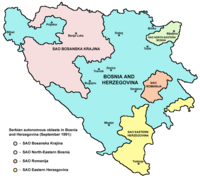
Serbian Autonomous Provinces from 1991 to 1992, created in rebellion against the government of Bosnia and Herzegovina.
The 1991 population census in Bosnia and Herzegovina counted 43.5% Bosniaks, 31% Serbs, and 17% Croats, the remainder being Yugoslavs and others. The first democratic multi-party elections in the republic were held on 18 November 1990. Most seats in its parliament were won by political parties that represented the three peoples: the Party of Democratic Action, the Serb Democratic Party, and the Croatian Democratic Union. The three parties reached a power sharing agreement covering all government bodies and public institutions.
In a session on 14 and 15 October 1991, the Parliament approved the "Memorandum on Sovereignty" as had already been done by Slovenia and Croatia. The Memorandum was adopted despite opposition from 73 Serb deputies, belonging to the Serb Democratic Party (most of the Serb parliamentary representatives) as well as the Serbian Renewal Movement and the Union of Reform Forces, who regarded the move as illegal.[14][15] On 24 October 1991, the Serb deputies formed the Assembly of the Serb People in Bosnia and Herzegovina (Skupština srpskog naroda u Bosni i Hercegovini) to be the highest representative and legislative body of the Serb population,[16][17] ending the tripartite coalition.
The Union of Reform Forces soon ceased to exist but its members remained in the assembly as the Independent Members of Parliament Caucus. The assembly undertook to address the achievement of equality between the Serbs and other peoples and the protection of the Serbs' interests jeopardized by decisions of the Bosnian parliament.[16] On 9 January 1992, the assembly proclaimed the Republic of the Serb People of Bosnia and Herzegovina (Republika srpskog naroda Bosne i Hercegovine), declaring it part of Yugoslavia.[18] On 28 February 1992 the assembly adopted the Constitution of the Serbian Republic of Bosnia and Herzegovina (the name adopted instead of the previous Republika srpskog naroda Bosne i Hercegovine). Its territory would include districts, municipalities, and regions where Serbs were the majority and also those where they had allegedly become a minority because of persecution during World War II. The republic was part of Yugoslavia and could enter into union with political bodies representing other peoples of Bosnia and Herzegovina.[19]
The Bosnian parliament, without its Serb deputies, held a referendum on the independence of Bosnia and Herzegovina on 29 February and 1 March 1992, but most Serbs boycotted it since the assembly had previously (9–10 November 1991) held a plebiscite in the Serb regions, 96% having opted for membership of the Yugoslav federation formed only by Serbia and Montenegro.[20] The referendum had a 64% turnout and 92.7% or 99% (according to different sources) voted for independence.[21][22] On 6 March the Bosnian parliament promulgated the results of the referendum, proclaiming the republic's independence from Yugoslavia. The republic's independence was recognized by the European Community on 6 April 1992 and by the United States on 7 April. On the same day the Serbs' assembly in session in Banja Luka declared a severance of governmental ties with Bosnia and Herzegovina.[23] The name Republika Srpska was adopted on 12 August 1992.[24]
The political controversy escalated into the Bosnian War, which would last until the autumn of 1995. According to numerous verdicts of the International Criminal Tribunal for the former Yugoslavia (ICTY) Bosnian Serb forces performed ethnic cleansing in their intended territories in order to create an ethnically pure state of Republika Srpska.[25] Republika Srpska's leadership including Biljana Plavšić,[26] Momčilo Krajišnik,[27] and Radoslav Brđanin[25] were indicted and judged guilty for war crimes and ethnic cleansing. The former president of Republika Srpska, Radovan Karadžić, is currently under trial.[28] The top military general, Ratko Mladić, was arrested on 26 May 2011 in connection with the siege of Sarajevo and the Srebrenica massacre.[29] The war was ended by the General Framework Agreement for Peace in Bosnia and Herzegovina, reached at Wright-Patterson Air Force Base near Dayton, Ohio, on 21 November and formally signed in Paris on 14 December 1995. Annex 4 of the Agreement is the current Constitution of Bosnia and Herzegovina, recognising Republka Srpska as one of its two main political-territorial divisions and defining the governmental functions and powers of the both entities. The boundary lines between the entities were delineated in Annex 2 of the Agreement.[30] From 1992 to 2008 the Constitution of Republika Srpska was amended 121 times. Article 1 states that Republika Srpska is a territorially unified, indivisible and inalienable constitutional and legal entity that shall independently perform its constitutional, legislative, executive, and judicial functions.[31]
Impact of war[]
Republika Srpska wartime territorial claims (black line) versus its present day boundaries, overlayed on the ethnic map based on 1981 census.
The war in Bosnia and Herzegovina resulted in major changes in the country, some of which were quantified in a 1998 UNESCO report. In the non-Serbian region 50% of houses were damaged and 6% destroyed while the number was lower in the Serbian region, 25% damaged and 5% destroyed[by whom?][citation needed]. Two million people, about half the country's population, were displaced. In 1996 there were some 435,346 Serbian refugees from the Federation in Republika Srpska while another 197,925 had gone to Serbia. In 1991, 27% of the non-agricultural labor force had been unemployed in Bosnia and this number had increased due to the war.[32] In 2009 the unemployment rate in Bosnia and Herzegovina was an estimated 29% according to the CIA's The World Factbook.[33] In 1996 unemployment in Republika Srpska was at 90%.
Republika Srpska's population of Serbs had increased by 547,741[when?] and ethnic cleansing considerably reduced the numbers of other groups.[34] The increase of the Serb population of the Republic was due to the influx of ethnic Serbs refugees from the Federation of Bosnia and Herzegovina and the former unrecognised state of Republika Srpska Krajina in Croatia.[35] The number of Croats was reduced by 135,386 (majority of prewar population), and the number of Bosniaks by some 434,144. Some 136,000 of approximately 496,000 Bosniak refugees and expulsees, forced to flee the territory of what is now Republika Srpska, have returned home.[36] As of 2008, 35% of Bosniaks and 8.5% of Croats have returned to Republika Srpska, while 24% of Serbs who left their homes in territories controlled by Bosniaks or Croats, have returned to their pre-war addresses.[37]
In the early 2000s discrimination against non-Serbs was alleged by NGOs and the Helsinki Commission. The International Crisis Group reported in 2002 that in some parts of Republika Srpska a returnee is ten times more likely to be the victim of violent crime than is a local Serb.[38] The Helsinki Commission, in a 2001 statement on "Tolerance and Non-Discrimination", also pointed at violence against non-Serbs, stating that in the cities of Banja Luka[39] and Trebinje,[40] mobs attacked people who sought to lay foundations for new mosques. There were indications of police collaboration. Non-Serbs have continued difficulty in returning to their original homes and the assembly has a poor record of cooperation in apprehending individuals indicted for war crimes, crimes against humanity, and genocide.[41]
Organizations such as the Society for Threatened Peoples, reporting to the United Nations Human Rights Council in 2008, claim that non-Serbian refugees returning to Republika Srpska are discriminated against and live under appalling conditions, particularly in the Drina Valley (Srebrenica, Bratunac, Višegrad, and Foča). Many are unemployed and children must attend schools where all subjects are taught in Serbian. Similar things are taking place in the Federation of Bosnia where the problem of segregation is very visible in Herzegovinan and some Bosnian cities where the population is predominantly Croatian. Separate schools for Croatians and non-Croatians are formed. Croatian nationality students are taught using Croatian curriculum whereas Serbian and Bosniak pupils are taught according to the curriculum of Bosnia and Herzegovina [42]
According to the Ministry for Human Rights and Refugees of Bosnia and Herzegovina, European Union Police Mission, UNHCR, and other international organizations, the security in both Republika Srpska and the Federation of Bosnia and Herzegovina is at present satisfactory, although some minor threats, real or perceived, can still influence the decision of individuals as to whether they will return to their pre-war addresses, or not.[37]
Geography[]
Boundary[]
The Inter-Entity Boundary Line (IEBL) between Bosnia and Herzegovina's two entities essentially follows the front lines at the end of the Bosnian War with adjustments (most importantly in the western part of the country and around Sarajevo) defined by the Dayton Agreement. The total length of the IEBL is approximately 1,080 km. The IEBL is an administrative demarcation uncontrolled by military or police and there is free movement across it.
Municipalities[]
Under the Law on Territorial Organization and Local Self-Government, adopted in 1994, Republika Srpska was divided into 80 municipalities. After the Dayton Peace Agreement the law was amended to reflect changes to borders: it now comprises 63 municipalities.
Demography[]

Ethnic structure of Republika Srpska according to the 1991 census.
There has been no census since the end of the war; recent figures are estimates.
| Year | Total | Males | Females | Births | Deaths |
|---|---|---|---|---|---|
| 1996 | 1,391,593 | 12,263 | 10,931 | ||
| 1997 | 1 409 835 | 13,757 | 11,755 | ||
| 1998 | 1,428,798 | 679,795 | 749,003 | 13,527 | 12,469 |
| 1999[note 1] | 1,448,579 | 689,186 | 759,351 | ||
| 2000[note 1] | 1,469,182 | 14,191 | 13,370 | ||
| 2000 | 1,428,899 | 695,194 | 733,705 | ||
| 2001[note 1] | 1,490,993 | 13,699 | 13,434 | ||
| 2001 | 1,447,477 | 704,197 | 743,280 | ||
| 2002 | 1,454,802 | 708,136 | 746,666 | 12,336 | 12,980 |
| 2003 | 1,452,351 | 706,925 | 745,426 | 10,537 | 12,988 |
| 2004 | 1,449,897 | 705,731 | 744,166 | 10,628 | 13,082 |
| 2005 | 1,446,417 | 704,037 | 742,380 | 10,322 | 13,802 |
| 2006 | 1,443,709 | 702,718 | 740,991 | 10,524 | 13,232 |
| 2007 | 1,439,673 | 700,754 | 738,919 | 10,110 | 14,146 |
| 2008 | 1,437,477 | 699,685 | 737,792 | 10,198 | 13,501 |
| 2009 | 1,435,179 | 698,567 | 736,612 | 10,603 | 13,775 |
| 2010 | 1,433,038 | 697,524 | 735,514 | 10,147 | 13,517 |
| 2011 | 1,429,668 | 695,884 | 733,784 | 9,561 | 13,658 |
| 2012 | 1,425,571 | 9,978 | 13,796 |
List of cities and municipalities in the Republika Srpska
Ethnic composition[]
| Ethnic Composition | |||||||||||||
| Year | Serbs | % | Bosniaks | % | Croats | % | Yugoslavs | % | Others | % | Total | ||
|---|---|---|---|---|---|---|---|---|---|---|---|---|---|
| 1991[44] | 869,854 | 55.4 | 440,746 | 28.1 | 144,238 | 9.2 | 75,013 | 4.8 | 39,481 | 2.5 | 1,569,332 | ||
Economy[]
The currency of Republika Srpska is the Bosnia and Herzegovina convertible mark (KM). It takes a minimum of 23 days to register a business there, whereas in the Federation of Bosnia and Herzegovina it often takes several months. Gross domestic product (PPP) was estimated in 2010 at about US$7,895 per capita, but growth in the particular area was measured as being the highest in Bosnia, with 6,5%.[45]
| GDP of Republika Srpska 2006–2011 (mil. KM)[46] | |||||
| 2006 | 2007 | 2008 | 2009 | 2010 | 2011 |
|---|---|---|---|---|---|
| 6,544 | 7,351 | 8,489 | 8,223 | 8,308 | 8,669 |
Foreign investment[]
An agreement on strategic partnership has been concluded between the Iron Ore Mine Ljubija Prijedor and the British company LNM (a major steel producer, now part of ArcelorMittal). The Russian company Yuzhuralzoloto also signed a strategic partnership with the Lead and Zinc Mine Sase Srebrenica. Recent foreign investments include privatisation of Telekom Srpske, sold to the Serbian Telekom Srbija for €646 million, and the sale of the petroleum and oil industry, based in Bosanski Brod, Modriča and Banja Luka, to Zarubezhneft of Russia, whose investment is expected to total US$970 million in coming years.[47] On 16 May 2007, the Czech power utility ČEZ signed a €1.4 billion contract with the Elektroprivreda Republike Srpske, to renovate the Gacko I power plant and build a second, Gacko II.[48] As of September 2012, the President of Republika Srpska, Milorad Dodik, has signed an agreement with the Russian company Gazprom to build a part of the South Stream pipeline network and two gas power plants in the entity.[49]
External trade[]
| External trade of Republika Srpska (mil. euros) (not including trade with the Federation of Bosnia and Herzegovina and the Brčko District)[50][51] | ||||||||||||
| Year | 2001 | 2002 | 2003 | 2004 | 2005 | 2006 | 2007 | 2008 | 2009 | 2010 | 2011 | 2012 |
|---|---|---|---|---|---|---|---|---|---|---|---|---|
| Exports | 306 | 289 | 312 | 431 | 578 | 788 | 855 | 983 | 855 | 1,114 | 1,309 | 1,214 |
| Imports | 868 | 1,107 | 1,165 | 1,382 | 1,510 | 1,411 | 1,712 | 2,120 | 1,825 | 2,072 | 2,340 | 2,294 |
| Total trade | 1,174 | 1,396 | 1,477 | 1,813 | 2,088 | 2,199 | 2,567 | 3,103 | 2,680 | 3,186 | 3,649 | 3,508 |
| Coverage (%) | 35 | 26 | 27 | 31 | 38 | 56 | 50 | 46 | 47 | 54 | 56 | 53 |
Taxation and salaries[]
Since 2001, Republika Srpska initiated significant reforms in the sector of the tax system, which lowered the tax burden to 28.6%, one of the lowest in the region. The 10% rate of capital gains tax and income tax are among the lowest in Europe and highly stimulating for foreign investment, and there are no limits on the amount of earnings. Increasing the number of taxpayers and budgeted incomes, and creating a stable fiscal system, were necessary for further reforms in the fields of taxation and duties; this area is a priority goal of the RS authorities. VAT has been introduced in 2006. Income tax is 46% in the RS, compared to nearly 70% in the Federation, and the corporate tax rate is 10%, compared to 30% in the Federation. These tax advantages have led to some companies moving their business to RS from the other entity.[45]
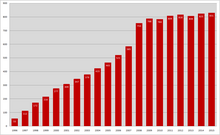
Average net wages (KM) in Republika Srpska 1996–2010[52]
Republika Srpska saw accelerated salary growth in 2008. The average net salary in 2008 amounted to KM 755 (€386), which represents an increase of 29% compared to 2007 average. High inflation rate in 2008 caused the difference between the nominal and the real salary growth to be higher than in 2007. Average net salaries in Republika Srpska saw a real growth of 21.8%, since 2008 inflation measured by Consumer Price Index was 7.2%. Marked salary growth was particularly contributed to by salary growth in individual economic sectors, especially in public sector. Regarding pensions in Republika Srpska, their growth in 2008 kept pace with salary trends. The average pension in 2008 amounted to KM 294 (€150), which is larger by 27.8% (y/y). Somewhat higher pension growth in the RS might be explained by significantly faster growth of contributions of the PDI Fund. The average wage as of January 2013 stood at KM 810.0 (€415).
Politics[]
National Assembly building, Banja Luka
Government building, Banja Luka (right).
Under its constitution, Republika Srpska has a president, parliament (the 83-member National Assembly of Republika Srpska), executive (with a prime minister and several ministries), its own police, supreme court and lower courts, customs service (under the state-level customs service), and postal service. It also has its own coat of arms, flag (a variant of the Serbian flag without the coat of arms displayed), and national anthem. However, the national anthem, like those of Spain, San Marino and Abu Dhabi, has no words to it. The Constitutional Law on Coat of Arms and Anthem of the Republika Srpska was ruled not in conformance with the Constitution of Bosnia and Herzegovina as it states that those symbols "represent statehood of the Republika Srpska" and are used "in accordance with moral norms of Serb people". According to the Constitutional Court's decision, the Law was to be corrected by September 2006. The national assembly of Republika Srpska formed a board which is going to make a proposal for the anthem and coat of arms of Republika Srpska. Although the constitution names Sarajevo as the capital of Republika Srpska, the northwestern city of Banja Luka is the headquarters of most of the institutions of government, including the parliament, and is therefore the de facto capital.
After the war, Republika Srpska retained its army, but in August 2005, the parliament consented to transfer control of Army of Republika Srpska to a state-level ministry and abolish the Republic's defense ministry and army by 1 January 2006. These reforms were required by NATO as a precondition of Bosnia and Herzegovina's admission to the Partnership for Peace. As of 14 December 2006, Bosnia and Herzegovina is a part of the Partnership for Peace programme.
External relations[]
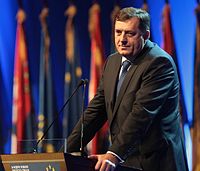
Milorad Dodik, the president of the Republika Srpska
On 26 September 2006, Republika Srpska officials signed a "special ties agreement" with Serbia aimed at promoting economic and institutional cooperation between Serbia and the Republika Srpska (RS). The accord was signed by Serbia's President Boris Tadić and Prime Minister Vojislav Koštunica, former RS President Dragan Čavić, and Prime Minister Milorad Dodik.
Tadić and Koštunica, accompanied by several ministers and some 300 businessmen, arrived in Banja Luka on two special planes from Belgrade, in what was seen as the biggest-ever boost to strengthening ties in all spheres of life between the Republika Srpska and Serbia. The Serbian Komercijalna banka and the Dunav osiguranje insurance company opened branches in Banja Luka and the Serbian news agency Tanjug also inaugurated its international press center in Banja Luka, on a day packed with business engagements.
The document sets out steps taken by Serbia and Republika Srpska officials to increase economic and political ties. It is similar to a previous one signed in 2001 between the Federal Republic of Yugoslavia and the Republika Srpska, which had envisaged close cooperation in economy, defense, education and dual citizenship for the residents, said a Serbian government statement. The agreement gives Republika Srpska, the same status with Serbia as the state of Bosnia-Herzegovina as a whole. "This agreement will stabilize the relations between countries in the region and it will promote economic, political, and cultural relations between Serbia and Republika Srpska", Čavić told reporters after the signing ceremony. Koštunica added "We have long waited for this day", and insisting that the agreement would not be "a dead letter on paper", but would "live and be useful to the citizens of Serbia and Republika Srpska".
Under the Dayton Agreement, which ended the Bosnian war in 1995, two entities – Federation of Bosnia and Herzegovina, and the Republika Srpska – formed a single state, but with many decentralised powers.
Representative offices[]

Representative offices of the Republika Srpska worldwide.
On 12 February 2009, Republika Srpska opened a new representative office in Brussels. While EU representatives were not present at the time, all top Republika Srpska officials attended the opening ceremony, saying it would advance their economic, political and cultural relations with the European Union. This notion has been strongly condemned by Bosniak leaders, saying that this is further proof of Republika Srpska distancing itself from Bosnia and Herzegovina. President Rajko Kuzmanovic, on the other hand, told reporters that this move does not jeopardize Republika Srpska's place within Bosnia and Herzegovina. He added that Republika Srpska just used its constitutional right "to open up a representation office in the center of developments with European relevance". Republika Srpska also has offices of representation in Belgrade (Serbia), Moscow (Russia), Stuttgart (Germany), Jerusalem (Israel)[53] and Vienna (Austria).[54][55] In 2009 there were plans to open offices in Washington D.C. and Zagreb.[56] Former Croatian Prime Minister Ivo Sanader previously stated "that certainly won't be nor can it be an embassy because the Republika Srpska government is not the government of a sovereign state nor can it be".[57]
Holidays[]

Saint Stephen is the patron saint of the Republika Srpska.
According to the Law on Holidays of Republika Srpska, passed by the National Assembly of Republika Srpska, the holidays are divided into three categories: the republic holidays, the religious ones, and the holidays not accompanied by leaves of absence. The republic holidays include Republic Day (9 January), New Year's Day, International Workers' Day, Victory over Fascism Day and Day of the General Framework Agreement for Peace in Bosnia and Herzegovina (21 November). The religious holidays include Christmas and Easter according to both the Julian and the Gregorian calendars, for the Orthodox and the Catholic citizens respectively, and Eid al-Adha and Eid ul-Fitr for the Muslims. The holidays not accompanied by leaves of absence include School Day (the Feast of Saint Sava, 27 January), Day of the Army of the Republika Srpska (12 May), Interior Ministry Day (4 April), and Day of the First Serbian Uprising (14 February).[58]
The most important of the republic holidays is Republic Day, which commemorates the establishment of Republika Srpska on 9 January 1992. It coincides with St. Stephen's Day according to the Julian calendar. The Orthodox Serbs also refer to the holiday as the Slava of Republika Srpska. They regard Saint Stephen The Protomartyr And Archdeacon as the patron saint of Republika Srpska. The holiday has therefore a religious dimension, being celebrated with special services in Orthodox churches.[59][60]
Culture[]
Education[]

University of Banja Luka
The oldest and largest public university in Republika Srpska is University of Banja Luka established in 1975. The second of two public universities in Republika Srpska is University of East Sarajevo. After the breakup of Yugoslavia and the end of war there has been established several private institutions of higher education: American University in Bosnia and Herzegovina, Slobomir University, University Sinergija and Paneuropean University "Apeiron" Banja Luka.
Sport[]
File:Gradski stadion Banja Luka, Septembre 2012.jpg|thumb|Gradski stadion (Banja Luka)|Banja Luka City Stadium Sport in Republika Srpska revolves mostly around team sports. Among the most popular sports are football, basketball, volleyball, handball and tennis. The main football clubs in Republika Srpska are FK Borac Banja Luka, FK Leotar, FK Slavija, FK Rudar Prijedor and the others. FK Borac Banja Luka is the most popular and most successful football club in the entity.
Banja Luka as a capital of Republika Srpska is well known as one of the most famous handball center in the Balkans. RK Borac Banja Luka won the European Champions' Cup in 1976. and EHF Cup in 1991. RK Borac Banja Luka players have won 6 Gold Olympic medals for former Yugoslavia.
A panorama of the Borac Banja Luka stadim
Gallery[]
Notes[]
References[]
- ↑ (Serbian) Srpska – Portal javne uprave Republike Srpske: Simboli at the Governament of Republika Srpska official website (retrieved 17 May 2012).
- ↑ "Constitution of the Republika Srpska, Official Web Site of the Office of the High Representative". http://www.ohr.int/ohr-dept/legal/oth-legist/doc/rs-constitution.doc.
- ↑ Office of High Representative in Bosnia and Herzegovina
- ↑ Office of High Representative in Bosnia and Herzegovina
- ↑ "Decision on Constitutional Amendments in Republika Srpska". Office of the High Representative. http://www.ohr.int/print/?content_id=7474. Retrieved 3 June 2010.
- ↑ (Serbian) Устав републике српске [Constitution of Republika Srpska]. Чланак 7 [Article 7]. Constitutional Court of Republika Srpska
- ↑ "Bosnia-Hercegovina profile". BBC. http://www.bbc.co.uk/news/world-europe-17211415. Retrieved 14 April 2013.
- ↑ 8.0 8.1 The Constitution of Republika Srpska official document, retrieved 17 May 2012 (Serbian)
- ↑ Related Articles. "Serb Republic (region, Bosnia and Herzegovina) – Britannica Online Encyclopedia". Britannica.com. http://www.britannica.com/EBchecked/topic/535337/Serb-Republic. Retrieved 29 August 2010.
- ↑ "Bosnian Serb republic leader dies". BBC News. 30 September 2007. http://news.bbc.co.uk/1/hi/world/europe/7021232.stm. Retrieved 22 May 2010.
- ↑ Moss, Paul (27 June 2009). "Bosnia echoes to alarming rhetoric". BBC News. http://news.bbc.co.uk/2/hi/8121166.stm. Retrieved 22 May 2010.
- ↑ Lyon, James (4 December 2009). "Halting the downward spiral". The New York Times. http://www.nytimes.com/2009/02/24/opinion/24iht-edlyon.1.20395827.html?_r=1. Retrieved 22 May 2010.
- ↑ Beaumont, Peter (3 May 2009). "Bosnia lurches into a new crisis". The Guardian. London. http://www.guardian.co.uk/world/2009/may/03/bosnia-war-nationalism-poor-economy. Retrieved 22 May 2010.
- ↑ Silber, Laura (16 October 1991). "Bosnia Declares Sovereignty". pp. A29. ISSN 0190-8286. http://www.washingtonpost.com/wp-srv/inatl/longterm/balkans/stories/independence101691.htm.
- ↑ Kecmanović, Nenad (23 September 1999). "Dayton Is Not Lisbon". NIN. ex-YU press. http://www.ex-yupress.com/nin/nin117.html. Retrieved 11 May 2009.
- ↑ 16.0 16.1 "The Decision on Establishment of the Assembly of the Serb People in Bosnia and Herzegovina" (in Serbian). 15 January 1992. p. 1.
- ↑ Women, violence, and war: wartime ... – Google Books. Google Books. 2000. ISBN 978-963-9116-60-3. http://books.google.com/books?id=_RSi4WL0RP8C&pg=PA12&lpg=PA12. Retrieved 29 August 2010.
- ↑ "The Declaration of Proclamation of the Republic of the Serb People of Bosnia and Herzegovina" (in Serbian). 27 January 1992. pp. 13–14.
- ↑ "The Constitution of the Serbian Republic of Bosnia and Herzegovina" (in Serbian). 16 March 1992. pp. 17–26.
- ↑ Kreća, Milenko (11 July 1996). "The Legality of the Proclamation of Bosnia and Herzegovina's Independence in Light of the Internal Law of the Socialist Federal Republic of Yugoslavia" and "The Legality of the Proclamation of Independence of Bosnia and Herzegovina in the Light of International Law" in "Dissenting Opinion of Judge Kreća" (PDF). Application of the Convention on the Prevention and Punishment of the Crime of Genocide, Preliminary Objections, Judgment, I. C. J. Reports 1996 (The Hague: The Registry of the International Court of Justice): pp. 711–747. ISSN 0074-4441.
- ↑ The Balkans: A Post-Communist History (2007, New York: Routledge) Robert Bideleux & Ian Jeffries, p. 343
- ↑ Saving strangers: humanitarian. Google Books. 2000. ISBN 978-0-19-829621-8. http://books.google.com/books?id=AYQLyuN4_twC&pg=PA249. Retrieved 29 August 2010.
- ↑ "The Decision on Proclamation of the Serbian Republic of Bosnia and Herzegovina" (in Serbian). Večernje novosti. Belgrade: Novosti AD. 8 April 1992. ISSN 0350-4999.
- ↑ "The Amendments VII and VIII to the Constitution of the Republika Srpska" (in Serbian). 29 September 1992. p. 569.
- ↑ 25.0 25.1 "Prosecutor v. Radoslav Brđanin – Judgement". UN International Criminal Tribunal for the former Yugoslavia. 3 April 2007. http://www.icty.org/x/cases/brdanin/acjug/en/brd-aj070403-e.pdf. Retrieved 3 November 2009.
- ↑ "Prosecutor v. Biljana Plavsic judgement". http://www.icty.org/x/cases/plavsic/tjug/en/pla-tj030227e.pdf. "Biljana Plavsic was sentenced to 11 years’ imprisonment."
- ↑ "Prosecutor v. Momcilo Krajisnik judgement". http://www.icty.org/x/cases/krajisnik/acjug/en/090317.pdf. "Sentenced to 27 years’ imprisonment"
- ↑ "Prosecutor v. Radovan Karadžić – Second Amended Indictment". UN International Criminal Tribunal for the former Yugoslavia. 26 February 2009. http://www.icty.org/x/cases/karadzic/ind/en/090218.pdf. Retrieved 18 August 2009.
- ↑ "Prosecutor v. Ratko Mladic – Amended Indictment". UN International Criminal Tribunal for the former Yugoslavia. 8 November 2002. http://www.icty.org/x/cases/mladic/ind/en/mla-ai021010e.pdf. Retrieved 18 August 2009.
- ↑ "The General Framework Agreement for Peace in Bosnia and Herzegovina". OHR. http://www.ohr.int/dpa/default.asp?content_id=380.
- ↑ "Constitution of Republika Srpska". The Constitutional Court of Republika Srpska. http://www.ustavnisud.org/html/pravno%20utemeljenje/ustav%20e.html.
- ↑ UNESCO (1998). "Review of the education system in the Republika Srpska". http://www.unesco.org/education/educprog/erd/english/com/docs/eur/bih2/srp_cont.html. Retrieved 10 January 2009.
- ↑ CIA – The World Factbook
- ↑ Judah. The Serbs. Yale University Press. pp. 225–241. ISBN 978-0-300-15826-7.
- ↑ Press Online Republika Srpska :: Od pola miliona, u FBiH ostalo 50.000 Srba
- ↑ "Written statement submitted by the Society for Threatened Peoples to the Commission of Human Rights; Sixtieth session Item 11 (d) of the provisional agenda". United Nations. 26 February 2004. p. 2. http://www.unhchr.ch/Huridocda/Huridoca.nsf/0/116959be7b8cf279c1256e5a003b5e6b?Opendocument.
- ↑ 37.0 37.1 Revidirana strategija Bosne i Hercegovine za provedbu Aneksa VII Dejtonskog mirovnog sporazuma. Ministry for Human Rights and Refugees of Bosnia and Herzegovina. October 2008.
- ↑ "The Continuing Challenge of Refugee Return in Bosnia & Herzegovina". Crisis Group. 13 December 2002. http://www.crisisgroup.org/home/index.cfm?id=1473&l=1.
- ↑ "UN Condemns Serb 'Sickness'". BBC. 8 May 2001. http://news.bbc.co.uk/2/hi/europe/1318283.stm. Retrieved 4 January 2010.
- ↑ "Serbs Block Bosnia Mosque Ceremony". BBC. 6 May 2001. http://news.bbc.co.uk/2/hi/europe/1315262.stm. Retrieved 4 January 2010.
- ↑ "Helsinki Commission Releases U.S. Statement on Tolerance and Non-Discrimination at OSCE Human Dimension Implementation Meeting". Helsinki Commission. 20 September 2001. http://www.csce.gov/index.cfm?FuseAction=UserGroups.Home&ContentRecord_id=188&ContentType=P&ContentRecordType=P&UserGroup_id=62&Subaction=ByDate&IsTextOnly=True&CFID=18849146&CFTOKEN=53.
- ↑ "7th Session of the UN Human Rights Council" (PDF). Society for Threatened Peoples. 21 February 2008. p. 2. http://forum-menschenrechte.de/cms/upload/PDF/ab_05-2008/aides_memoires/Bosnia_Herzegowina-GfbV.pdf.
- ↑ "Republika Srpska in Figures 2009". Banja Luka: Republika Srpska Institute of Statistics. 2009. Archived from the original on 1 April 2010. http://web.archive.org/web/20100401005601/http://www.rzs.rs.ba/Publikacije/RSuBrojkama/RSuBrojkama2009.pdf. Retrieved 5 July 2010.
- ↑ Federation Office of Statistics (May 2008). "Population of the Federation Bosnia and Herzegovina 1996 – 2006", p.20, [1]
- ↑ 45.0 45.1 Kampschror, Beth (15 May 2007). "Bosnian Territory Opens Doors for Business". The Wall Street Journal. http://online.wsj.com/article/SB117918783695002652.html?mod=googlenews_wsj. Retrieved 17 June 2007.
- ↑ Baza podataka o ekonomskim indikatorima Republike Srpske – IRBRS
- ↑ "Investicija za preporod privrede BiH". Nezavisine novine. 25 January 2007. http://www.nezavisne.com/vijesti.php?vijest=4941&meni=2. Retrieved 19 April 2007.
- ↑ "CEZ signs contract on energy project in Bosnia". Prague Daily Monitor. 17 May 2007. Archived from the original on 21 May 2007. http://web.archive.org/web/20070521220708/http://launch.praguemonitor.com/en/86/czech_business/6620/. Retrieved 17 June 2007.
- ↑ Bosnia's Serb Entity Signs up for South Stream Pipeline :: Balkan Insight
- ↑ Статистички годишњак 2012
- ↑ http://www.rzs.rs.ba/front/article/332/?left_mi=None&add=None
- ↑ http://web.archive.org/web/20120123125601/http://www.rzs.rs.ba/Publikacije/Godisnjak/2011/StatistickiGodisnjak2011-WEB.pdf
- ↑ Представништва Републике Српске у иностранству
- ↑ Biznis.ba – U Beču otvoreno Predstavništvo Republike Srpske
- ↑ Dodik otvorio predstavništvo Republike Srpske u Beču – VESTI – SMEDIA
- ↑ "Republika Srpska EU Office Triggers Dispute". BalkanInsight.com. http://www.balkaninsight.com/en/article/republika-srpska-eu-office-triggers-dispute. Retrieved 29 August 2010.
- ↑ Prime Minister Sanader receives Lajcak at the Wayback Machine (archived 20 December 2007)
- ↑ "Zakon o praznicima Republike Srpske" (in Serbian). Zakoni. National Assembly of Republika Srpska. 27 July 2005. http://www.narodnaskupstinars.net/lat/zakoni/zakon.php?id_zakona=110. Retrieved 10 April 2009.
- ↑ "President of the Republic organises a reception on the occasion of the Day of the Republic and Patron Saint’s Day of the Republic of Srpska". Announcements. Official presentation of the Republic of Srpska President. 9 January 2009. http://www.predsjednikrs.net/en_l/news.php?id=284. Retrieved 10 April 2009.[dead link]
- ↑ "Прослављена слава Републике Српске – Свети архиђакон Стефан" (in Serbian). The Serbian Orthodox Church. 9 January 2008. http://www.spc.rs/sr/proslavljena_slava_republike_srpske_sveti_arhidjakon_stefan. Retrieved 10 April 2009.
External links[]
| Wikimedia Commons has media related to Republika Srpska. |
- Government of Republika Srpska
- President of Republika Srpska
- National Assembly of Republika Srpska
- RS Institute of Statistics
- Republika Srpska ~ Moja Republika
The original article can be found at Republika Srpska and the edit history here.



